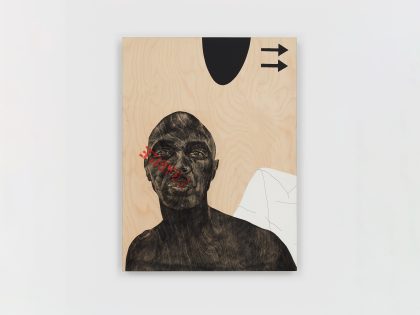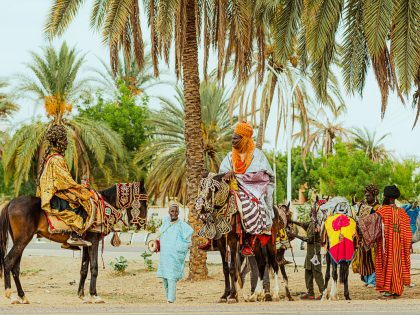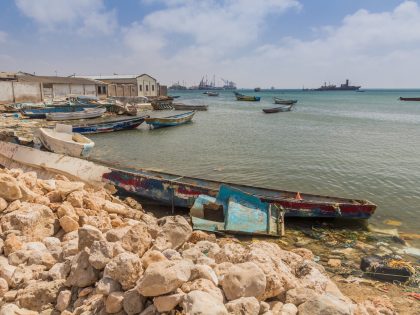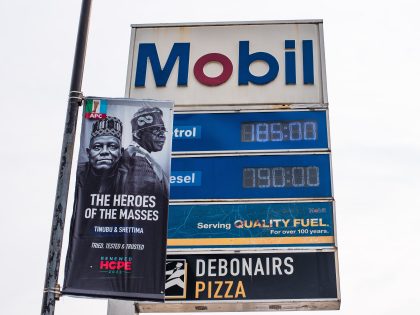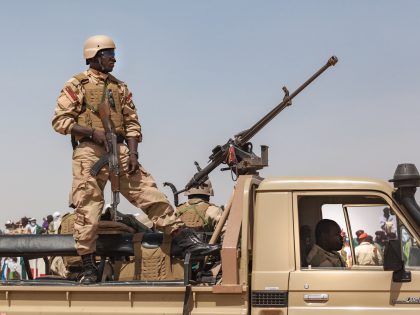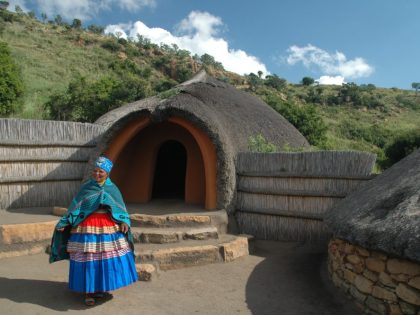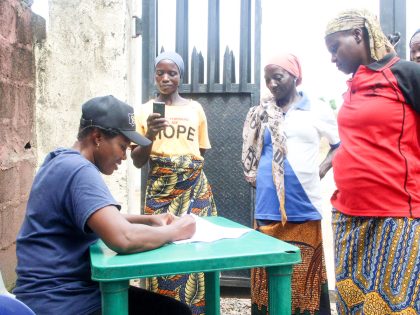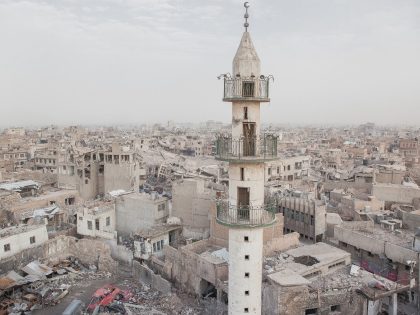Les Fantômes

A painting sits glowering on the wall of the Jack Bell Gallery in London. Figures daubed in bright colours stare out from the canvases against a dark background broken up by bits of newspaper cuttings. This is Les Fantômes, the work of Aboudia, a 26-year-old Ivorian painter whose stark images have recently been receiving some much-deserved attention.
In January, Aboudia was working in a studio in Abidjan without electricity. He remained in the city throughout the conflict which broke out in response to the contested 2010 election. His studio was right next to the Golf Hotel, which Ouattara’s party used as their headquarters, and the artist came dangerously close to the conflict, forced to remain inside for days, and often retreating to his cellar when the fighting was nearby. Jack Bell recalls him talking about the burning of bodies in the lot next to his studio, how he observed the three stages of decomposition, grew to know the stench, the different colours of the smoke.
Since then, things have been changing fast. A German artist, Stefan Meisel, saw his work on Facebook, immediately bought two paintings, and offered to represent him. Aboudia has received plenty of press for the intimacy of his art with the conflict. An article by Reuters carried the headline: “Ivorian artist paints as bullets whizz overhead”. Aboudia had his first show earlier this year, also at the Jack Bell Gallery, taking his first aeroplane flight to see it. After three days in London he was impatient to return to his studio. His work is due to feature at the forthcoming Painters’ Painters exhibition at the commercial Saatchi Gallery. He is currently on his way to New York to collect his green card.
Two of Aboudia’s paintings feature in Les Fantomes, a group exhibition of Central and West African artists.
These are the first work of his post-conflict work to be exhibited, and the explicitly political content of the earlier work has been replaced by mythology. The signifiers of war are absent, and the figures evoke the vodou talismans of the northern militia. If the conflict has abated, its phantoms are filling this work. Aboudia’s second painting in this exhibition, The White King (pictured above), uses similar motifs. But the crown has a registered trademark symbol; the language of these paintings exceeds and resists that of global capitalism.
There appears to be a content to these works that resists being easily imported to the galleries of Europe. In Aboudia’s work, tribal art is often worked over, erased, and reappears in the reworkings of magazine images. The visual debts to Jean-Michel Basquiat is already one of the stock responses associated with this work, but the real influences are closer to home. The scrawled writing on these canvases are reminders that graffiti, and the culture of the street is of primary importance. The words are often from nouchi, the Ivorian argot originating in Abidjan, the slang of child soldiers.
The complex of local and global in Aboudia’s work are presented as part of a dialogue with the other African artists appearing in Les Fantomes. The extraordinary coffins sculpted by Paa Joe, a prostitute-shaped tomb for a prostitute, or a little Mercedes for a car mechanic, statements about their inhabitant’s life work, are at once joyful and colourfully macabre. Leonce Raphael Agbodjelou’s photographs apply the highly-stylised approach of his studio portraits to the ceremonial figures of local ritual in Benin. The other photographer in the exhibition, Hamidou Maiga, documents Mali’s transition into independence and modernity. The Congolese artist, Steve Bandoma takes body parts from magazine clippings reassembling them with watercolour and ink into strange and delicate chimeras. Afedzi Hughes, a Ghanian artist now based in New York, makes paintings which negotiate their own hybridities, measuring an Adidas football boot against a gun, the imported image with associated forms of violence.
The proximity of Aboudia’s personal narrative to violence and suffering is the main reason this work has attracted attention, but the intensity and thoughtfulness of his mark-making is justification enough. In May he claimed to have hung up his “war brushes” and started a series on “the children of Abobo train station”. In this work, the explicitly political referents which gives the war paintings their resonance with the European satire of Goya and Picasso are no longer to be found, replaced by a playful and brutal infancy. It will be interesting to see whether the interest in his work maintains if the phantoms with the conflict which has given it its aura of authenticity recede. But it is clear that, whatever happens with next month’s elections in Abidjan, Aboudia’s powers of description will not be wasted.
The next exhibition at the Jack Bell Gallery is the Egungun Project, Leonce Raphael Agbodjelou, 17 November – 17 December 2011.
* Orlando Reade is a teacher and writer based in London.











